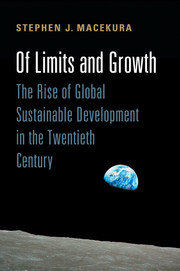Book contents
- Frontmatter
- Contents
- List of Illustrations
- Acknowledgments
- Introduction: NGOs and the Origins of “Sustainable Development”
- PART ONE ORIGINS
- 1 The Rise of International Conservation and Postwar Development
- 2 Parks and Poverty in Africa: Conservation, Decolonization, and Development
- 3 “The World's Most Dangerous Political Issue”: The 1972 Stockholm Conference and the Politics of Environmental Protection
- PART TWO REFORMS
- PART THREE PERSISTENT PROBLEMS
- Conclusion: The Growth and Limits of NGOs
- Archives
- Index
3 - “The World's Most Dangerous Political Issue”: The 1972 Stockholm Conference and the Politics of Environmental Protection
from PART ONE - ORIGINS
Published online by Cambridge University Press: 05 July 2015
- Frontmatter
- Contents
- List of Illustrations
- Acknowledgments
- Introduction: NGOs and the Origins of “Sustainable Development”
- PART ONE ORIGINS
- 1 The Rise of International Conservation and Postwar Development
- 2 Parks and Poverty in Africa: Conservation, Decolonization, and Development
- 3 “The World's Most Dangerous Political Issue”: The 1972 Stockholm Conference and the Politics of Environmental Protection
- PART TWO REFORMS
- PART THREE PERSISTENT PROBLEMS
- Conclusion: The Growth and Limits of NGOs
- Archives
- Index
Summary
“The relationship between man and his environment is undergoing profound changes in the wake of modern scientific developments” began a resolution put before the UN's General Assembly on December 3, 1968. These profound changes were global in scope and presented harrowing problems for people across the world. Rapid population growth and industrialization in developing countries coupled with continued economic growth in the developed world created concerns about potential exhaustion of important raw materials, especially energy sources. Industrial air and water pollution had no regard for boundaries between states, igniting complicated diplomatic disputes and endangering natural systems and human well-being. Excessive use of technologies, such as industrial fertilizers and nuclear power plants, with potentially deleterious unintended consequences imperiled human health and threatened the very material abundance of contemporary society that such technologies had helped to create.
Alarmed by these events, leaders of major states began to take notice of the environmental problems that activists such as Julian Huxley and Russell Train had been worried about for years. Riding the tide of environmental concern sweeping the developed world in the 1960s, the Swedish government put forth a proposal to convene an international conference, under UN auspices, to bring all nations together to address these environmental problems. Backed by the General Assembly on December 3, the UN called for the June 1972 meeting to be dedicated to the “human environment.” It was necessary, the UN resolution claimed, to “focus the attention of Governments and public opinion on the importance and urgency of this question and also to identify those aspects of it that can only or best be solved through international cooperation and agreement.” The gathering, to be held in Stockholm, Sweden, was designed to do just that.
The Stockholm Conference also signaled the rapid broadening of what quickly became called the “environmental movement.” Whereas the World Wildlife Fund (WWF) and the International Union for the Conservation of Nature (IUCN) had focused mostly on engaging developing nations and relied mostly on personal leverage to generate support among individual national leaders, by the late 1960s a broader movement, buoyed by a new generation of activists, turned to grassroots activism to promote policy changes in donor governments and new environmental values in the United States and Europe. This prompted cleavages within the wider environmental movement.
- Type
- Chapter
- Information
- Of Limits and GrowthThe Rise of Global Sustainable Development in the Twentieth Century, pp. 91 - 134Publisher: Cambridge University PressPrint publication year: 2015
- 1
- Cited by



